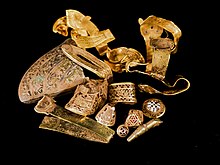Portal:Staffordshire/Selected article/4
The Staffordshire Hoard is the largest hoard of Anglo-Saxon gold and silver metalwork yet found[update]. Discovered in a field near the village of Hammerwich, near Lichfield, in Staffordshire, England, on 5 July 2009, it consists of over 3,500 items that are nearly all martial in character and contains no objects specific to female uses. The artefacts have tentatively been dated to the 7th or 8th centuries, placing the origin of the items in the time of the Anglo-Saxon kingdom of Mercia. Experts have produced a range of theories as to where the hoard came from and how it came to be deposited, and whether the objects were made for Christians or pagans. The average quality of the workmanship is extremely high and especially remarkable in view of the large number of individual objects, such as swords or helmets, from which the elements in the hoard came.
The hoard has been described by Leslie Webster, former keeper of the department of prehistory at the British Museum, as "absolutely the metalwork equivalent of finding a new Lindisfarne Gospels or Book of Kells." She stated further that "this is going to alter our perceptions of Anglo-Saxon England as radically, if not more so, as the Sutton Hoo discoveries." Dr Roger Bland, Head of the Portable Antiquities Scheme, said, "It is a fantastically important discovery. It is assumed that the items were buried by their owners at a time of danger with the intention of later coming back and recovering them."
The hoard was valued at £3.285 million and has now been purchased by the Birmingham Museum & Art Gallery and the Potteries Museum & Art Gallery.

